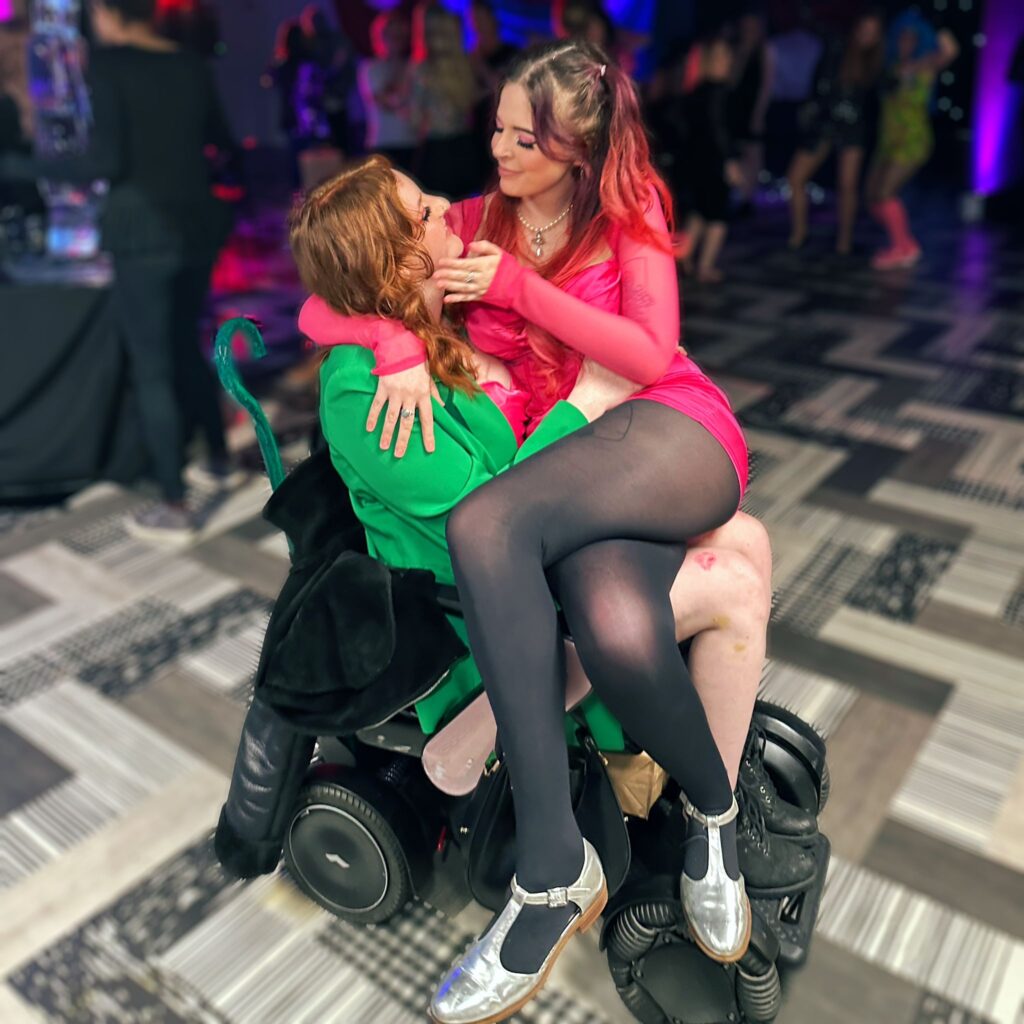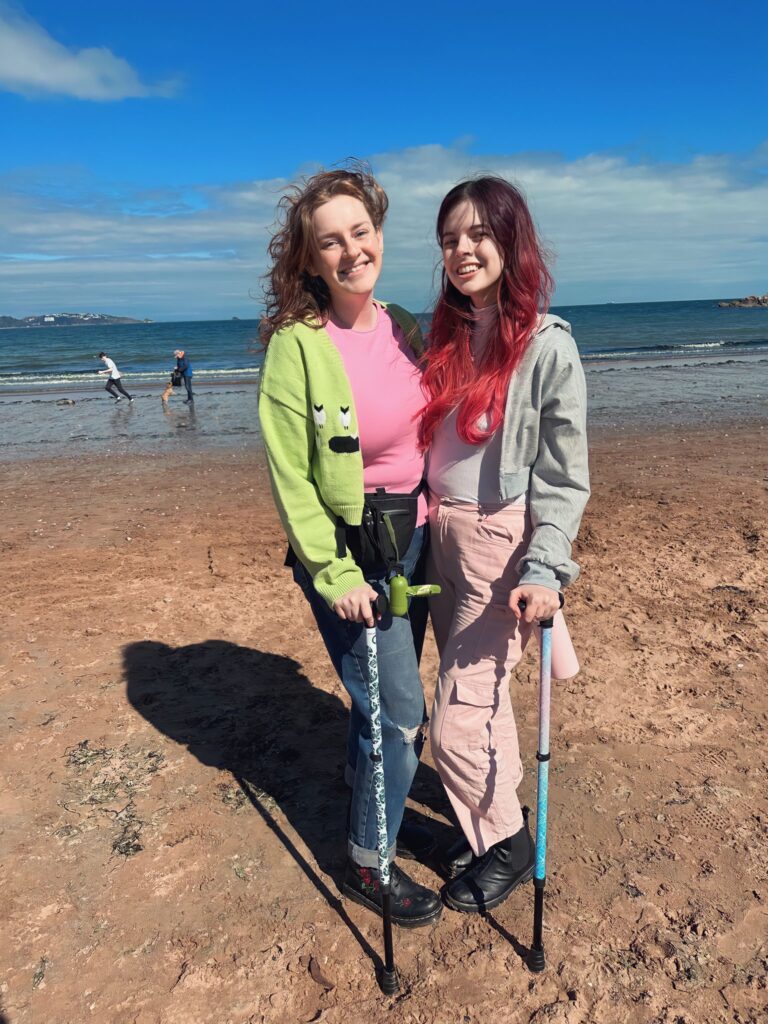As a queer, disabled couple, my partner and I face ableism and homophobia combined when we go out together
Jeffie is a content creator and disability activist based in the south west of England. She has Ehlers-Danlos syndrome, postural orthostatic tachycardia syndrome, chronic fatigue syndrome, and fibromyalgia. This means she experiences widespread chronic pain as well as chronic fatigue, mobility issues and daily joint dislocations.
In this blog for Pride Month, she explains how coming out as queer and dating another disabled person has opened her eyes to the ways in which homophobia and ableism intersect.

I am disabled and queer, and these are two inextricable parts of what makes me who I am.
I became aware of both my queerness and my disability gradually. Getting my diagnosis at 25, much like realising my sexuality, felt like turning on a light. Everything finally made sense.
My identities are multifaceted. I often face barriers, whether it’s other people’s attitudes, or physical barriers and accessibility issues. However, there are also positives – I’ve built a wonderful community of LGBTQIA+ and disabled people online.
Through this online space I met my current partner Ru (she/they). They are a femme person who is also queer and disabled. Since being in a relationship with her, I’ve become more acutely aware of the overlapping discrimination we face when we go out as a queer, disabled couple.
It’s not just us. In 2022, more than 11,000 disability hate crimes were recorded – a 43% increase on the previous year. Homophobic hate crimes have also doubled in the last five years.
These are worrying statistics, making it clear that this is an important conversation to have this Pride Month.
Going out as a disabled couple involves lots of planning
There are so many things Ru and I need to consider when we go out together. First, we have to think about our mode of transport – will both of our wheelchairs fit in the taxi?
If we want to travel, we have to research how safe our destination is for queer couples, as well as whether it’s accessible (which it often isn’t).
Nothing is ever straightforward. Recently, I wanted to book us in to see a show at the theatre. The staff member almost refused to book us in without a “carer”, even though I told him this wasn’t necessary. As we’re two people going out in wheelchairs, it’s expected that we have someone to look after us.
Granted, there are times when we need someone to come along and help. But this is not always needed. It’s frustrating when people won’t listen to us or believe us when we say what we do or don’t need.
When we do go out, we experience double the ableism
“I vividly remember one of the first times we were out together in our wheelchairs. It was as if we were animals in a zoo.”
Unlike my sexuality, my disability is mostly visible, since I use a wheelchair. I’ve experienced lots of ableism when I’m out in public, such as being refused entry to places, as my wheelchair would “take up too much space”.
My partner and I are both wheelchair users, so when we’re out and about together – even without the added layer of being queer – we draw negative attention.
I vividly remember one of the first times we were out together in our wheelchairs in a supermarket. It was as if we were animals in a zoo – the amount of people who stared at us was so much more than when either of us go out with non-disabled friends and family or alone.
Our disabilities make us more vulnerable to homophobia

We’ve also experienced homophobia throughout our relationship, and this is always exhausting to navigate. There have been times when we have had to stop being affectionate in public after receiving verbal abuse.
One of the more extreme cases of overlapping discrimination we faced was from a group of mainly women at a bar. I had my wheelchair parked near us, and Ru and I were both stood with our walking sticks having a little dance.
We were approached by the group, who initially infantilised us for being disabled people out enjoying ourselves. This is pretty common – disabled people are often portrayed as “inspirational” for leaving our homes and trying to live our lives.
Once the women realised we were actually a couple, this then took a turn into us being fetishised for being queer. Again, this is a common experience, but the group seemed especially fascinated by the fact we were a couple and both disabled.
Sadly, this led to very inappropriate actions and suggestions from the group, leaving us feeling vulnerable and in pain and shaken.
Someone within their group poured a drink on my wheelchair, and tried to break the joystick. The dread I felt in that moment was insurmountable. My wheelchair is my freedom, it is essentially my legs.
Situations like these are scary enough, but when you add disability into the mix, it means we are much more vulnerable. We’re often physically unable to get away when we feel or are unsafe.
Our relationship challenges stereotypes about disability and queerness
Whenever I tell a person that I’m gay it’s usually accepted without question, but the same thing does not always happen with disability. We are often met with questions, scepticism or the age-old exclamation: “You’re too young to be using a wheelchair”.
I often face even more scepticism when people realise that my partner is also disabled. Disabled people are desexualised, and it doesn’t help that we don’t have basic rights like marriage equality or being able to move in together without affecting our benefits.
“Existing in a disabled, queer relationship challenges people’s attitudes daily. Even when it’s tough, I’m proud that my relationship is encouraging people around me to think differently.”
Because of this view of disabled people not being sexual beings who experience love and pleasure, sometimes our relationship is seen as “less than”.
Queer relationships are also often considered “less than”, due to living in a heteronormative society. It can be difficult for people outside of LGBTQIA+ or disabled spaces to understand our relationship.
When entering relationships as a disabled person, it’s often expected that you’ll find someone else who is also disabled. But the reality is that, when you do, society isn’t able to understand. On the other hand, if you date someone who isn’t disabled, they are perceived to be some kind of hero for being with someone who is disabled.
Through thick and thin, my partner and I face it all together
Before being with Ru, I had internalised ableism that made me believe that I couldn’t be in a relationship with another disabled person. I believed that I was too much hard work, and I would need to be with someone physically able-bodied. But then Ru and I fell in love, and I realised I couldn’t have been more wrong.
Despite the challenges we face, we face these together and every difficulty is worth it.
Being in a relationship where the other person knows you so well, and truly understands your overlapping identities and how these effect your day-to-day life is wonderful.
Existing in a disabled, queer relationship challenges people’s attitudes daily. Even when it’s tough, I’m proud that my relationship is encouraging people around me to think differently.
Throughout this Pride Month I have seen small amounts of progress in making LGBTQIA+ spaces more accessible for disabled people. We need to capture this momentum to keep improving things.
Education is the most essential tool we have at our disposal. We need to work together to build a world where everyone, regardless of identity feels welcome and safe.
Celebrating the LGBTQ+ community
Here at Sense, we’re all about inclusion. We’re proud to support the LGBTQ+ community this Pride Month.
Want more stories like this in your inbox?
Sign up to get inspiring stories, news from our campaigns and ways to get involved, all delivered to your inbox.

